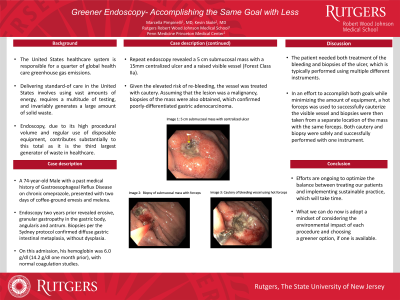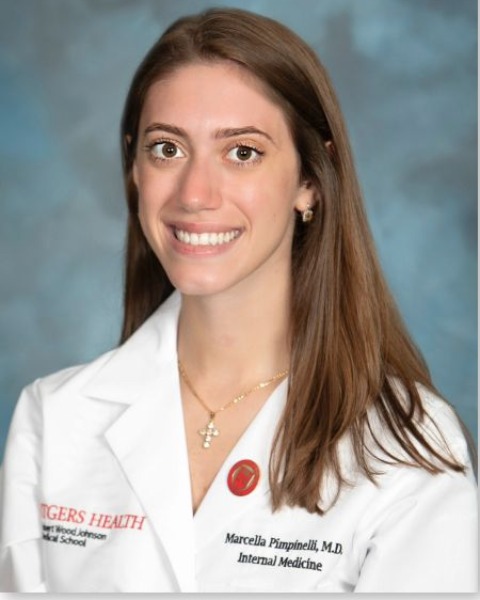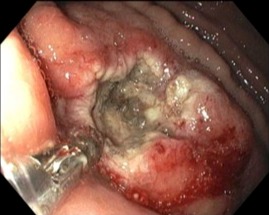Monday Poster Session
Category: General Endoscopy
P2006 - Greener Endoscopy- Accomplishing the Same Goal With Less
Monday, October 23, 2023
10:30 AM - 4:15 PM PT
Location: Exhibit Hall

Has Audio

Marcella Pimpinelli, MD
Rutgers Robert Wood Johnson Medical School
New Brunswick, New Jersey
Presenting Author(s)
Marcella Pimpinelli, MD1, Kevin Skole, MD2
1Rutgers Robert Wood Johnson Medical School, New Brunswick, NJ; 2Penn Medicine Princeton Medical Center, Plainsboro, NJ
Introduction:
The United States healthcare system is responsible for a quarter of global health care greenhouse gas emissions- more than any other nation. Delivering standard-of care in the United States involves using vast amounts of energy, requires a multitude of testing, and invariably generates a large amount of solid waste. Endoscopy, due to its high procedural volume and regular use of disposable equipment, contributes substantially to this total as it is the third largest generator of waste in healthcare.
Case Description/Methods:
A 74-year-old man with a past medical history of Gastroesophageal Reflux Disease on chronic omeprazole, presented with two days of coffee-ground emesis and melena. Endoscopy two years prior revealed erosive, granular gastropathy in the gastric body, angularis and antrum. Biopsies per the Sydney protocol confirmed diffuse gastric intestinal metaplasia, without dysplasia. On this admission, his hemoglobin was 6.0 g/dl (14.2 g/dl one month prior), with normal coagulation studies. Repeat endoscopy revealed a 5 cm submucosal mass with a 15mm centralized ulcer and a raised visible vessel (Forest Class IIa). Given the elevated risk of re-bleeding, the vessel was treated with cautery. Assuming that the lesion was a malignancy, biopsies of the mass were also obtained which confirmed poorly-differentiated gastric adenocarcinoma.
In this case, the patient needed both treatment of the bleeding and biopsies of the ulcer. Gastroenterologists generally treat bleeding and subsequently obtain samples using multiple different instruments. In an effort to accomplish both goals while minimizing the amount of equipment, a hot forceps was used to successfully cauterize the visible vessel and biopsies were then taken from a separate location of the mass with the same forceps. Both cautery and biopsy were safely and successfully performed with one instrument.
Discussion:
We are all responsible to do our part in reducing the solid waste we generate, whether it be through improved waste segregation, increased recycling or avoidance of single-use items where possible. Efforts are ongoing to optimize the balance between treating our patients and implementing sustainable practice, but finding the answers will take time. What we can do now, however, is adopt a mindset of considering the environmental impact of each procedure and choosing a greener option, if one is available.

Disclosures:
Marcella Pimpinelli, MD1, Kevin Skole, MD2. P2006 - Greener Endoscopy- Accomplishing the Same Goal With Less, ACG 2023 Annual Scientific Meeting Abstracts. Vancouver, BC, Canada: American College of Gastroenterology.
1Rutgers Robert Wood Johnson Medical School, New Brunswick, NJ; 2Penn Medicine Princeton Medical Center, Plainsboro, NJ
Introduction:
The United States healthcare system is responsible for a quarter of global health care greenhouse gas emissions- more than any other nation. Delivering standard-of care in the United States involves using vast amounts of energy, requires a multitude of testing, and invariably generates a large amount of solid waste. Endoscopy, due to its high procedural volume and regular use of disposable equipment, contributes substantially to this total as it is the third largest generator of waste in healthcare.
Case Description/Methods:
A 74-year-old man with a past medical history of Gastroesophageal Reflux Disease on chronic omeprazole, presented with two days of coffee-ground emesis and melena. Endoscopy two years prior revealed erosive, granular gastropathy in the gastric body, angularis and antrum. Biopsies per the Sydney protocol confirmed diffuse gastric intestinal metaplasia, without dysplasia. On this admission, his hemoglobin was 6.0 g/dl (14.2 g/dl one month prior), with normal coagulation studies. Repeat endoscopy revealed a 5 cm submucosal mass with a 15mm centralized ulcer and a raised visible vessel (Forest Class IIa). Given the elevated risk of re-bleeding, the vessel was treated with cautery. Assuming that the lesion was a malignancy, biopsies of the mass were also obtained which confirmed poorly-differentiated gastric adenocarcinoma.
In this case, the patient needed both treatment of the bleeding and biopsies of the ulcer. Gastroenterologists generally treat bleeding and subsequently obtain samples using multiple different instruments. In an effort to accomplish both goals while minimizing the amount of equipment, a hot forceps was used to successfully cauterize the visible vessel and biopsies were then taken from a separate location of the mass with the same forceps. Both cautery and biopsy were safely and successfully performed with one instrument.
Discussion:
We are all responsible to do our part in reducing the solid waste we generate, whether it be through improved waste segregation, increased recycling or avoidance of single-use items where possible. Efforts are ongoing to optimize the balance between treating our patients and implementing sustainable practice, but finding the answers will take time. What we can do now, however, is adopt a mindset of considering the environmental impact of each procedure and choosing a greener option, if one is available.

Figure: Cautery of visible vessel using hot forceps
Disclosures:
Marcella Pimpinelli indicated no relevant financial relationships.
Kevin Skole indicated no relevant financial relationships.
Marcella Pimpinelli, MD1, Kevin Skole, MD2. P2006 - Greener Endoscopy- Accomplishing the Same Goal With Less, ACG 2023 Annual Scientific Meeting Abstracts. Vancouver, BC, Canada: American College of Gastroenterology.
